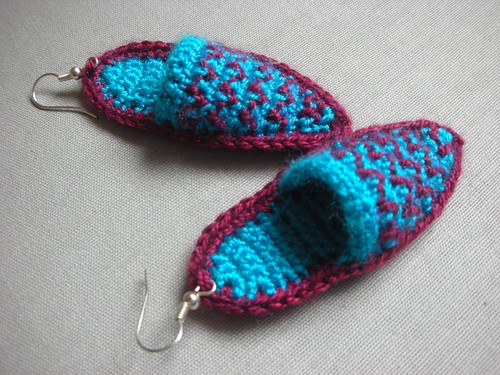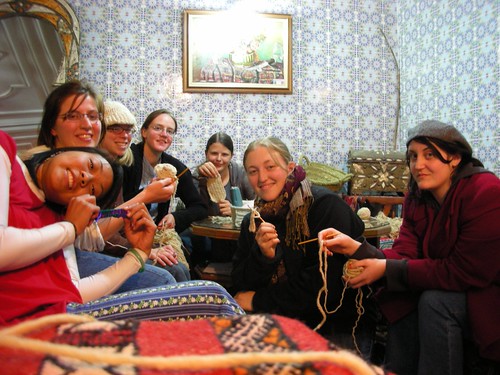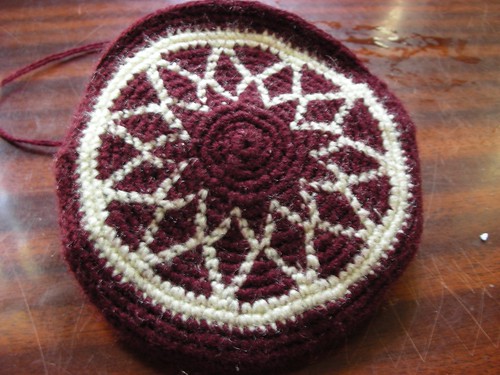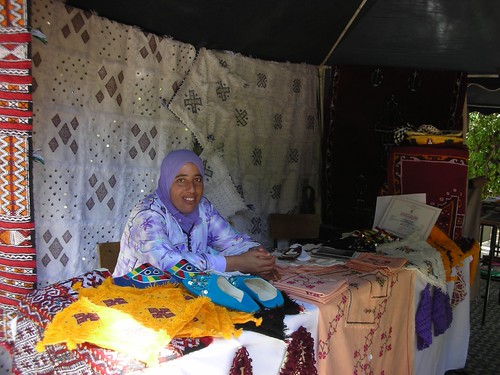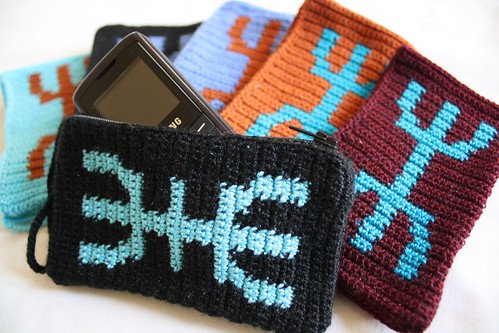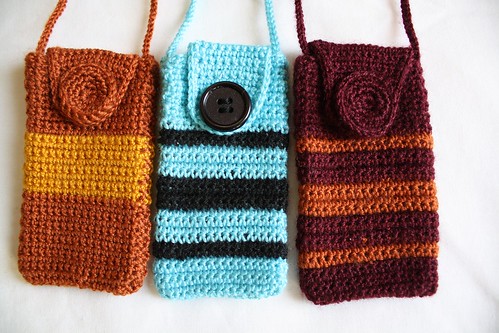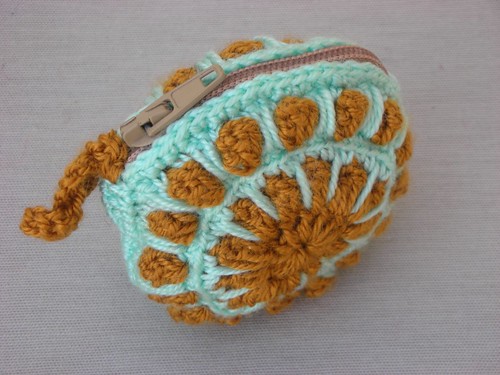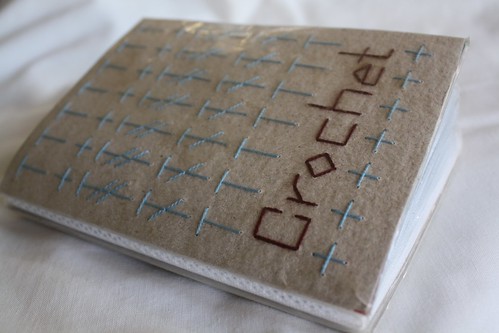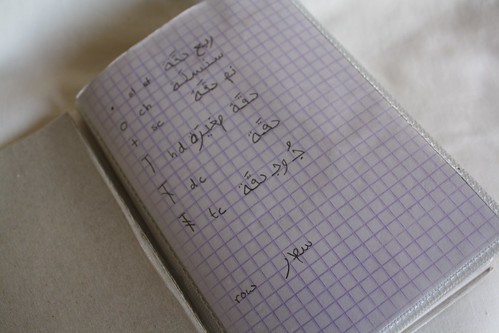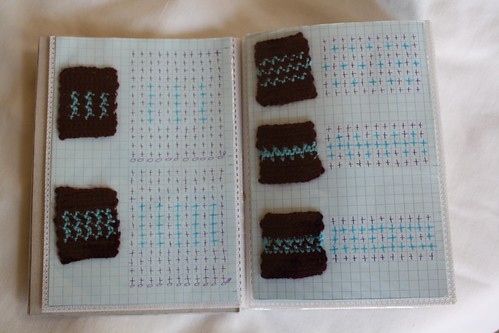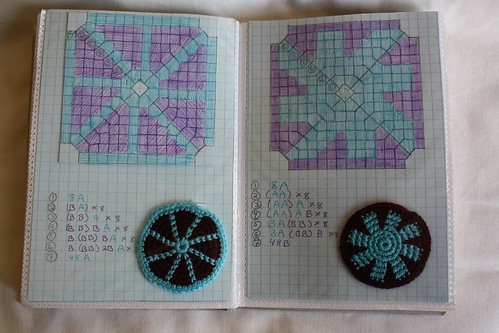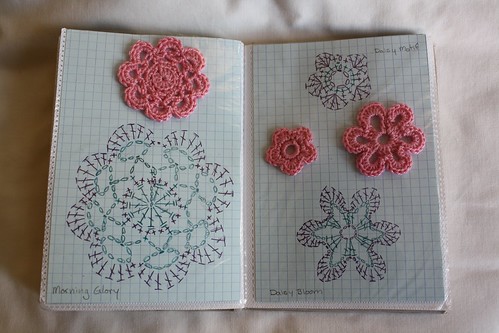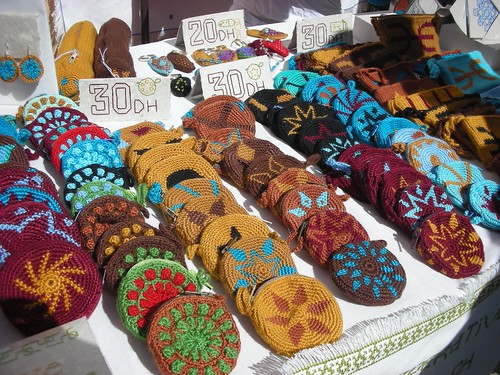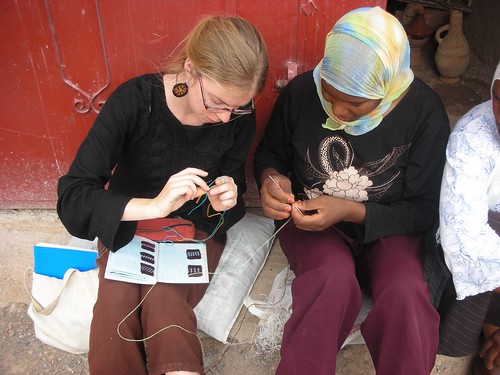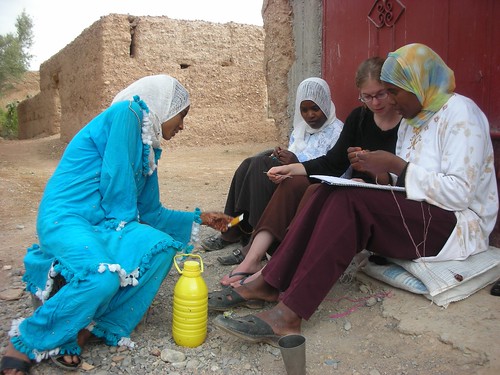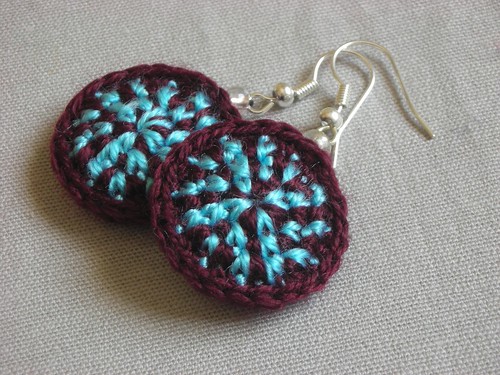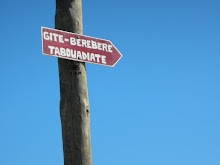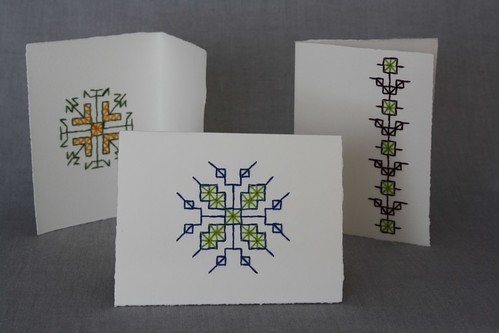
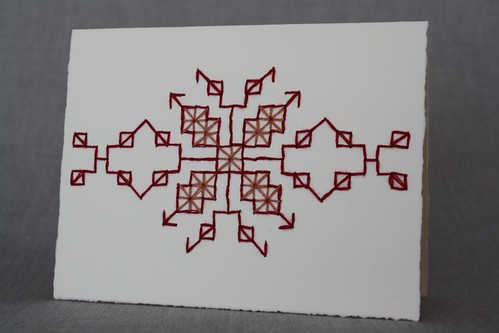
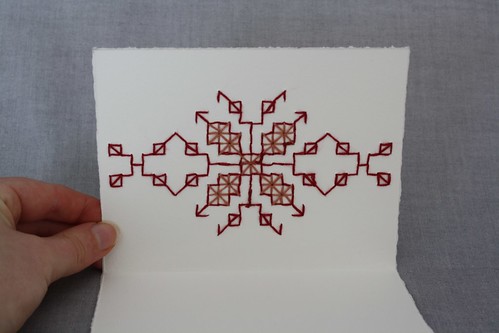
This May I will be teaching an embroidery class at Crafty Goodness. In the class, I will introduce a very unique and traditional style of embroidery known in Morocco as "Fesi," after the well-know city of Fez (or Fes, as it is spelled in Morocco). One of the things that makes Fesi so unique is that it is completely reversible! So, as part of the class, we will be making greeting cards, thus accentuating this wonderful aspect of the embroidery. To sign up for the class click here. (more details to follow at end of post).
Now for a little background as to how I came to learn this technique. As a Peace Corps Volunteer in Morocco (2008-2010), I was assigned to work with a women's handicraft cooperative and though the women are very talented, they needed some help with product development and marketing.
At first, I mostly concentrated on helping them with their crochet work, since crochet was a technique I was already familiar with. However, I desperately wanted to work with developing products with the Fesi embroidery that would be more marketable for them.
Traditionally, this type of embroidery is done on a grand scale. Women embroider large table cloths, densely covered in stitching, and make napkins to match. These tableware sets can take months to finish. The end result is that, though beautiful, the products are either so expensive hardy anyone can afford them, or more commonly, they are priced at an amount which severely undervalues the maker's time and craftsmanship.
Below, Lisa Payne, a fellow Peace Corps volunteer, worked with Fatima (right), who is one of the most skillful fesi embroiderers I've ever seen. Here they are with a table-cloth that Lisa commissioned Fatima to make for her parents. Photo courtesy of Lisa Payne.
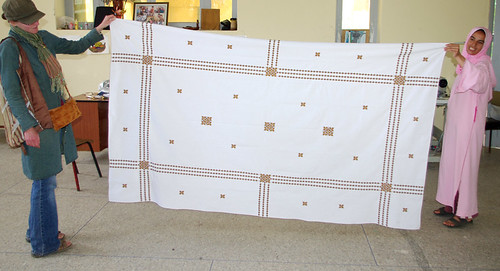
And this is another beautiful custom piece made by Fatima for Lisa's friends. Look at the detail! Now that's a lot of work! (Photos by Lisa Payne).
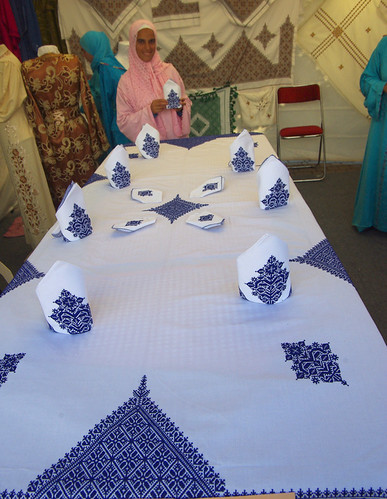

Now you get an idea of what I'm talking about when I say that these pieces take months to make. To counteract this, some volunteers who work with embroiders try to help them come up with new products that showcase the lovely technique, yet are smaller, take less time, cost less to buy and make, and therefore are generally more attractive to the growing tourist market. Some groups have started making small items such as handkerchiefs and coin purses.
In the case of Al Falah (the cooperative that I worked with), I taught the women how to embroider on paper so that they could make greeting cards and bookmarks. They even learned how to make handmade paper (out of egg cartons and toilet paper rolls) to do so, since thick, good quality paper is hard to come by in Morocco. Below are greeting cards made by the women of the cooperative using their own handmade paper.
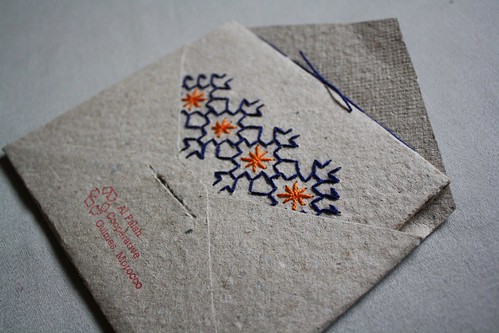
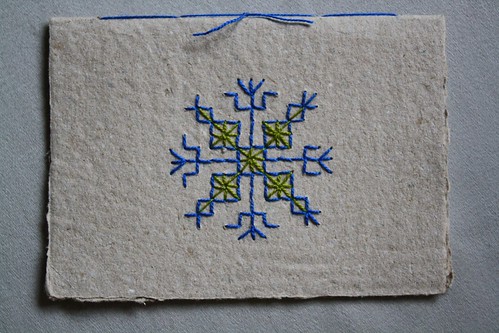
When coming up with new products for the co-op to try (such as the cards), I quickly learned that actual, finished prototypes were the best way to communicate my ideas. That meant I would need to learn the "right way" of making this embroidery.
You see, what makes Fesi embroidery so unique isn't just the intricate, beautiful, traditional designs that originated in the region near Fez. It's the fact that it is completely reversible. When done correctly, there is practically no difference between the front and the back of the work. Below are a pair of handkerchiefs made by a woman who worked with another Peace Corps Volunteer. The two handkerchiefs are identical but the one on the left shows the front of the handkerchief while the one on the right shows the back.
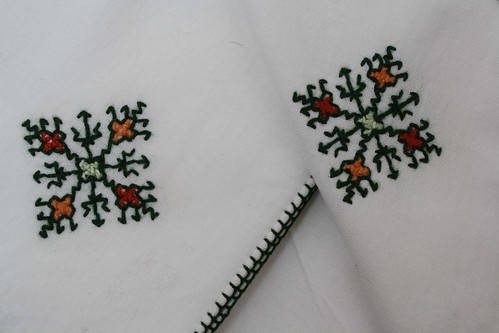
So in December of 2009, about one year into my Peace Corps service, I started to learn the Fesi technique. I learned it the same way that generations of women have learned before me, by apprenticing under a master (in this case, the principal embroidered of the cooperative, Hafida) and made a sampler. Below is my sampler along with detail photos.


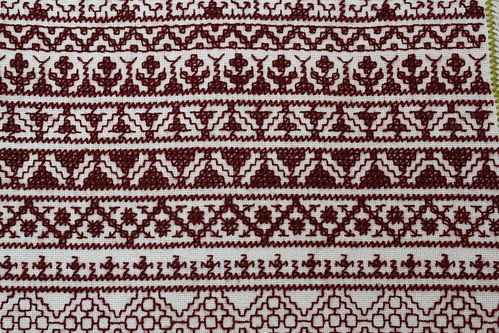
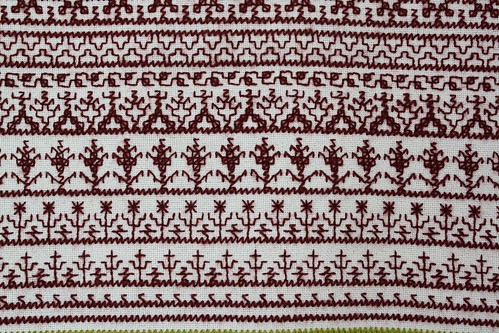
The sampler starts at the bottom with the most simple, rudimentary stitch and works its way to the more complicated designs at the top. After about the fifth row I no longer needed Hefida to get me started on each design and could figure out how to do the designs on my own just from looking at other samplers at the co-op or a pattern book. On days that we didn't have other workshops or activities planned, I would bring in my sampler and Hefida would check over my work. The 9 1/2 x 19 inch sampler wasn't completed until April, 2010 and most of the work was done while I was sick with pneumonia for about three weeks and could do little else.
Being an American, learning Fesi embroidery had a very similar effect as learning Moroccan Arabic had, that is to say, it endeared me to Moroccan women. Not only was Hafida and the rest of the co-op proud that I had made the effort to learn the technique, but Fatima (the co-op's most talented crocheter but didn't know how to do Fesi embroidery) soon wanted to learn as well. This was important because at the time the co-op had a t-shirt order to fill with an American company called Mushmina. I had introduced the co-op to Mushmina after meeting the owners, Heather and Katie O'Neill, in a nearby town. The sisters had just started their company and were looking for co-ops to work with and, since Heather was a Returned Peace Corps Volunteer who served in Morocco, they were led to the area where I was working at the time. Below (top photo) Oumaima, an apprentice, works on a black t-shirt for Mushmina while cooperative member Fatima (bottom photo, left) and apprentice Fatima (right) work on two sleeves of the same purple shirt.


As the co-op worked at a feverish pace to finish their last t-shirts order in the summer of 2010, I decided to show my support by doing a Fesi embroidered t-shirt myself. I did this partly because I wanted to see for how difficult it is to do this type of embroidery on t-shirt material and to apprieciate the amount of time that goes into making just one shirt. It was clear when they first received the order, along with the gorgeous t-shirts sent by Mushmina, that this was going to be a challenging project. The t-shirts were oh so soft and stretchy, which made doing the embroidery incredibly difficult. Sometimes just getting the shirts into the embroidery hoops would tear the delicate fabric. Below are detail photos of the t-shirt that I embroidered. The embroidery runs the entire lower edge of the shirt, about 37 inches total and took about 2 weeks to complete (it would take the co-op about 7-10 days for a similar amount of embroidery). In order to have a grid in which to embroider, a mesh material is placed on the top of the fabric and then unraveled to reveal the design after it is completely done.
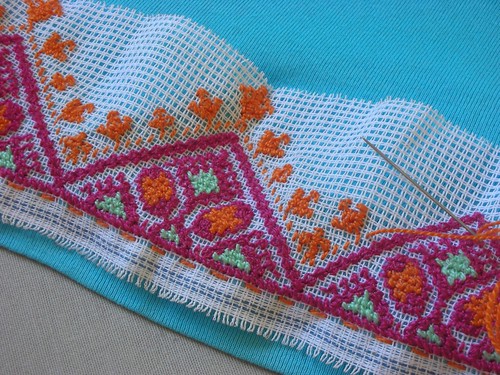


I'm so glad that I had the opportunity to work with such a great group of women and learn this amazing embroidery technique in the process. I hope that the women continue making and selling small items (in addition to their larger ones), so as to keep the technique alive for generations to come. By writing this post and teaching Fesi embroidery here in the US, I hope to make Americans aware of and interested in this beautiful and unique art from Morocco.
If you are in the Cleveland area and enjoy embroidery or at least admire this technique, I hope that you will join me on Sunday, May 22, 2011 from 2-4 pm at Crafty Goodness. The cost of the class is just $25 and will hold up to 6 people, so we will have a nice intimate atmosphere in which to work. To sign up for the class click here. The class is listed by date and under the title Fesi (Moroccan Embroidery). I hope to see you there!
Make sure to like zween on Facebook if you liked this post and want to be updated on future posts about classes, crafty news, stories, and much more!
Below and top of post: Fesi embroidered greeting cards on high-quality art paper by zween.

